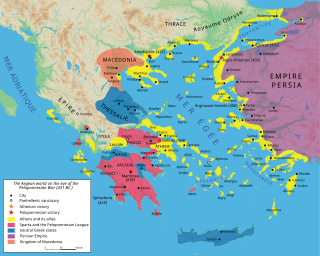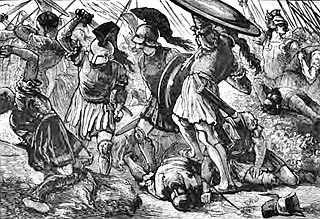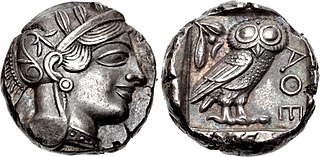Related Research Articles

The Delian League, founded in 478 BC, was an association of Greek city-states, numbering between 150 and 330, under the leadership of Athens, whose purpose was to continue fighting the Persian Empire after the Greek victory in the Battle of Plataea at the end of the Second Persian invasion of Greece.

The Peloponnesian War was an ancient Greek war fought between Athens and Sparta and their respective allies for the hegemony of the Greek world. The war remained undecided for a long time, until the decisive intervention of the Persian Empire in support of Sparta. Led by Lysander, the Spartan fleet, built with Persian subsidies, finally defeated Athens and started a period of Spartan hegemony over Greece.

The 5th century BC started the first day of 500 BC and ended the last day of 401 BC.

Pericles was a Greek politician and general during the Golden Age of Athens. He was prominent and influential in Athenian politics, particularly between the Greco-Persian Wars and the Peloponnesian War, and was acclaimed by Thucydides, a contemporary historian, as "the first citizen of Athens". Pericles turned the Delian League into an Athenian empire and led his countrymen during the first two years of the Peloponnesian War. The period during which he led Athens, roughly from 461 to 429 BC, is sometimes known as the "Age of Pericles", but the period thus denoted can include times as early as the Persian Wars or as late as the following century.
This article concerns the period 449 BC – 440 BC.
This article concerns the period 429 BC – 420 BC.
Year 446 BC was a year of the pre-Julian Roman calendar. At the time, it was known as the Year of the Consulship of Barbatus and Fusus. The denomination 446 BC for this year has been used since the early medieval period, when the Anno Domini calendar era became the prevalent method in Europe for naming years.

Evia also known by its antique spelling Euboea is the second-largest Greek island in area and population, after Crete, and the sixth largest island in the Mediterranean Sea. It is separated from Boeotia in mainland Greece by the narrow Euripus Strait. In general outline it is a long and narrow island; it is about 180 km (110 mi) long, and varies in breadth from 50 km (31 mi) to 6 km (3.7 mi). Its geographic orientation is from northwest to southeast, and it is traversed throughout its length by a mountain range, which forms part of the chain that bounds Thessaly on the east, and is continued south of Euboia in the lofty islands of Andros, Tinos and Mykonos.

The Battle of Artemisium or Artemision was a series of naval engagements over three days during the second Persian invasion of Greece. The battle took place simultaneously with the land battle at Thermopylae, in August or September 480 BC, off the coast of Euboea and was fought between an alliance of Greek city-states, including Sparta, Athens, Corinth and others, and the Persian Empire of Xerxes I.

The Battle of Chaeronea was fought in 338 BC, near the city of Chaeronea in Boeotia, between Macedonia under Philip II and an alliance of city-states led by Athens and Thebes. The battle was the culmination of Philip's final campaigns in 339–338 BC and resulted in a decisive victory for the Macedonians and their allies.

Timotheus was a Greek statesman and general who sought to revive Athenian imperial ambitions by making Athens dominant in a Second Athenian League. He was the son of the Athenian general, Conon. Isocrates considered that Timotheus was superior to the other commanders of his time and showed all the requisites and abilities of a good general.
Cleitarchus or Clitarchus was tyrant of Eretria in Euboea.
Peace of Philocrates is the name of the peace treaty concluded in 346 BC between Athens and Macedon under Philip II. Philocrates was the name of the main Athenian negotiator of the Treaty.
The First Peloponnesian War was fought between Sparta as the leaders of the Peloponnesian League and Sparta's other allies, most notably Thebes, and the Delian League led by Athens with support from Argos. This war consisted of a series of conflicts and minor wars, such as the Second Sacred War. There were several causes for the war including the building of the Athenian long walls, Megara's defection and the envy and concern felt by Sparta at the growth of the Athenian Empire.
In Ancient Greece, phoros was the name for the membership dues paid to Athens by the members of the Delian League, formed to offer protection from Persian forces. It could be paid in military equipment or money, most usually the latter. Consequently, a great deal of funds was paid to Athens for the purpose of military initiatives. Athens increased its military forces, resulting in its becoming a dominant and wealthy power.

The siege of Eretria took place in 490 BC, during the first Persian invasion of Greece. The city of Eretria, on Euboea, was besieged by a strong Persian force under the command of Datis and Artaphernes.

The History of Sparta describes the history of the ancient Doric Greek city-state known as Sparta from its beginning in the legendary period to its incorporation into the Achaean League under the late Roman Republic, as Allied State, in 146 BC, a period of roughly 1000 years. Since the Dorians were not the first to settle the valley of the Eurotas River in the Peloponnesus of Greece, the preceding Mycenaean and Stone Age periods are described as well. Sparta went on to become a district of modern Greece. Brief mention is made of events in the post-classical periods.

The first Persian invasion of Greece, during the Greco-Persian Wars, began in 492 BC, and ended with the decisive Athenian victory at the Battle of Marathon in 490 BC. The invasion, consisting of two distinct campaigns, was ordered by the Persian king Darius the Great primarily in order to punish the city-states of Athens and Eretria. These cities had supported the cities of Ionia during their revolt against Persian rule, thus incurring the wrath of Darius. Darius also saw the opportunity to extend his empire into Europe, and to secure its western frontier.

Under the reign of Philip II, the ancient Greek kingdom of Macedonia, initially at the periphery of classical Greek affairs, came to dominate Ancient Greece in the span of just 25 years, largely thanks to the character and policies of its king. In addition to utilising effective diplomacy and marriage alliances to achieve his political aims, Philip II was responsible for reforming the ancient Macedonian army into an effective fighting force. The Macedonian phalanx became the hallmark of the Macedonian army during his reign and the subsequent Hellenistic period. His army and engineers also made extensive use of siege engines.

The Athenian coinage decree also known as the Standards decree was a decree made by the Athenians to standardise currency amongst the states with whom they were allied. Between the years of 450 and 447 BC, the use of Athenian silver currency and Athenian weights and measures was made obligatory in all allied states of the Athenian Empire.
References
- ↑ IG I3 40, Akp. Mus. 6509, R. Meiggs and D. M. Lewis, A Selection of Greek Historical Inscriptions to the End of the Fifth Century BC, Oxford, 1988. 52
- ↑ Terry Buckley (1996). Aspects of Greek History . Routledge. p. 180. ISBN 0-415-54976-0.
- ↑ Pamela Bradley (2001). Ancient Greece - Using Evidence. Cambridge University Press. p. 177. ISBN 0-521-79646-6.
- ↑ Terry Buckley (1996). Aspects of Greek History . Routledge. p. 191. ISBN 0-415-54976-0.
- ↑ Pamela Bradley (2001). Ancient Greece - Using Evidence. Cambridge University Press. p. 183. ISBN 0-521-79646-6.
- ↑ Pamela Bradley (2001). Ancient Greece - Using Evidence. Cambridge University Press. p. 282. ISBN 0-521-79646-6.
- ↑ Terry Buckley (1996). Aspects of Greek History . Routledge. p. 191. ISBN 0-415-54976-0.
- ↑ Terry Buckley (1996). Aspects of Greek History . Routledge. p. 292. ISBN 0-415-54976-0.